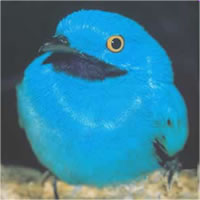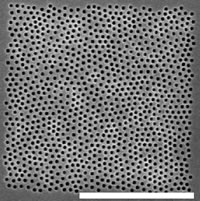I couldn’t resist the Superman reference although it really should have been a Morpho butterfly or a jewel beetle reference since these are two other animals/insects that also display unusual optical properties courtesy of nanoscale structures.

Top: Male eastern bluebird (Sialia sialis, Turdidae). Credit: Ken Thomas (image in public domain). Published in Soft Matter, 2009, 5, 1792-1795. E.R. Dufresne et al., “Self-assembly of amorphous biophotonic nanostructures by phase separation.” Royal Society of Chemistry. http://dx.doi.org/10.1039/B902775K
According to the Oct. 12, 2011 news item on Nanowerk,
Researchers at Yale University are studying how two types of nanoscale structures on the feathers of birds produce brilliant and distinctive colors. The researchers are hoping that by borrowing these nanoscale tricks from nature they will be able to produce new types of lasers—ones that can assemble themselves by natural processes. The team will present their findings at the Optical Society’s (OSA) Annual Meeting, Frontiers in Optics (FiO) 2011, taking place in San Jose, Calif. next week. [It starts Sunday, Oct. 16, 2011.]
Devin Powell, in a May 13, 2011 article for Science News provides some additional detail,
The barbs of these feathers [from bluebirds, blue jays, and parrots] contain tiny pockets of air. Light striking the tightly packed air bubbles scatters, bringing out deep shades of blues and ultraviolet (which birds can see but humans can’t).
“Birds use these structures to create colors that they can’t make in other ways,” says Richard Prum, an ornithologist at Yale University who discovered the mechanism behind this color.
To make a two-dimensional imitation of a bird feather, Yale physicist Hui Cao and her colleagues punched holes into a thin slice of gallium arsenide semiconductor. The holes were arranged like people in a crowd — somewhat haphazardly but with small-scale patterns that dictate roughly how far each hole is from its neighbor.
“The lesson we learned from nature is that we don’t need something perfect to get control,” says Cao, whose team describes their laser in the May 6 [2011] Physical Review Letters.
The latest work being presented is described this way in an Oct. 2011 news release (why aren’t people putting dates on their news releases????) from the Optical Society of America,
Inspired by feathers, the Yale physicists created two lasers that use this short-range order to control light. One model is based on feathers with tiny spherical air cavities packed in a protein called beta-keratin. The laser based on this model consists of a semiconductor membrane full of tiny air holes that trap light at certain frequencies. Quantum dots embedded between the holes amplify the light and produce the coherent beam that is the hallmark of a laser. The researchers also built a network laser using a series of interconnecting nano-channels, based on their observations of feathers whose beta-keratin takes the form of interconnecting channels in “tortuous and twisting forms.” The network laser produces its emission by blocking certain colors of light while allowing others to propagate. In both cases, researchers can manipulate the lasers’ colors by changing the width of the nano-channels or the spacing between the nano-holes.
What makes these short-range-ordered, bio-inspired structures different from traditional lasers is that, in principle, they can self-assemble, through natural processes similar to the formation of gas bubbles in a liquid. This means that engineers would not have to worry about the nanofabrication of the large-scale structure of the materials they design, resulting in cheaper, faster, and easier production of lasers and light-emitting devices.
Here’s an image of a ‘feather-based laser’,

Top: A laser based on feathers with the sphere-type nanostructure. This laser consists of tiny air holes (black) in a semiconductor membrane; each hole is about 77 nanometers across. (Scale bar = 5 micrometers.) Credit: Hui Cao Research Laboratory / Yale University.
As for the Morpho butterfly and jewel beetle, I last posted about gaining inspiration from these insects (biomimicry) in my May 20, 2011 posting in the context of some anti-counterfeiting strategies.
I first came across some of this work on the optical properties of nanostructures in nature in a notice about a 2008 conference on iridescence at Arizona State University. Here’s the stated purpose for the conference (from the conference page),
A unique, integrative 4–day conference on iridescent colors in nature, Iridescence: More than Meets the Eye is a graduate student proposed and organized conference supported by the Frontiers in Life Sciences program in Arizona State University’s School of Life Sciences. This conference intends to connect diverse groups of researchers to catalyze synthetic cross–disciplinary discussions regarding iridescent coloration in nature, identify new avenues of research, and explore the potential for these stunning natural phenomena to provide novel insights in fields as divergent as materials science, sexual selection and primary science education.